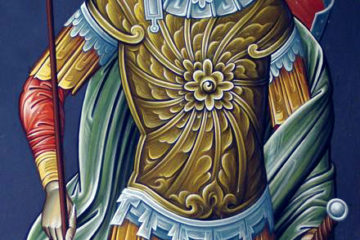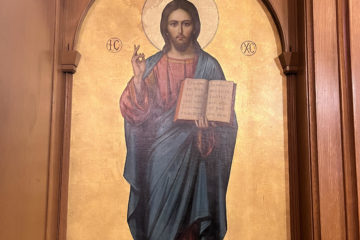Since then we have a great high priest who has passed through the heavens, Jesus, the Son of God, let us hold fast our confession. For we have not a high priest who is unable to sympathize with our weaknesses, but One who in every respect has been tempted as we are, yet without sin. Let us then with confidence draw near to the throne of grace, that we may receive mercy and find grace to help in time of need. For every high priest chosen from among men is appointed to act on behalf of men in relation to God, to offer gifts and sacrifices for sins. He can deal gently with the ignorant and wayward, since he himself is beset with weakness. Because of this he is bound to offer sacrifice for his own sins as well as for those of the people. And one does not take the honor upon himself, but he is called by God, just as Aaron was. So also Christ did not exalt himself to be made a high priest, but was appointed by Him who said to him, “Thou art my Son, today I have begotten Thee”; as he says also in another place, “Thou art a priest forever, after the order of Melchizedek.” Hebrews 4:14-16; 5:1-6 (Epistle from Sunday of Veneration of the Holy Cross)
We believe that Jesus is not only fully God, but in His earthly ministry, was fully man. He took part in our existence in the same way that we experience it. He came into this world as a baby, had a childhood where He went to school, had friends, went to the temple with His parents, etc. We know from reading the Bible that He has lots of human experiences. He got tired. (John 4:6) He cried. (John 11:35) He got hungry. (Matthew 4:2) He got thirsty. (John 19:28) He got angry. (John 2:15) He was tempted. (Matthew 4:1)
So, when Jesus tells us to be kind to others, He showed us by example how to be kind. When He tells us to love our neighbor, He showed us by example how to love our neighbor. And when He tells us that the great love a man can have is to lay down his life for a friend, He showed us by example in laying down His life for all of us. Jesus doesn’t ask us to do anything that He hasn’t done first Himself.
The difference between Jesus’ human experience and ours, was that He was able to negotiate through all the challenges and temptations of life without sin. He was tempted in every way that we are tempted. Yet, He kept His actions and His words in line with God’s commandments to love Him and to love one another. In all of His temptations, Christ did not sin.
In the Temple, before the time of Christ, there was a curtain which separated the Holy of Holies from everyone else. One priest, the High Priest, would enter the Holy of Holies once a year to offer a sacrifice for the sins of the people. He had to include his own sins as well. He “mediated” on behalf of the people, going on their behalf into this sacred place to offer sacrifices for the sins of all, including his own.
Christ now is seen as the “High Priest.” In fact, on the Bishop’s Throne in our churches, there is an icon of Christ, the High Priest. He is vested in the garments of a Bishop. He stepped forward, on behalf of the people, to “mediate” with God on our behalf, offering Himself as a sacrifice for the sins of all. He had no sin, so unlike the High Priest, His offering was not for Himself, but strictly for us.
Like the High Priests of the time, Christ did not demand this title, but was chosen by God to fulfill this role. We read in Hebrews 5:1, “For every high priest chosen from among men is appointed to act on behalf of men in relation to God, to offer gifts and sacrifices for sins.” Christ was chosen by God to fulfill this role, acting on our behalf, in relation to God, offering gifts and sacrifices for sins. In the case of Jesus, the sacrifice was HIMSELF. We read in Hebrews 5:2, “He can deal gently with the ignorant and wayward, since He Himself is beset with weakness.” Jesus felt our human frailties, but did not succumb to them.
Over the centuries, there have been controversies as to whether Jesus both fully human and fully divine, perfect God and perfect man. A quick look at the Creed confesses that we believe “in one Lord, Jesus Christ, the only-begotten Son of God, begotten of the Father before all ages.” This acknowledges Christ as eternal with the Father and the Holy Spirit. We then confess, “who for us men and for our salvation, came down from heaven and was incarnate of the Holy Spirit and the Virgin Mary and became man. He was crucified for us under Pontius Pilate, and suffered and was buried.” This acknowledges the fully human existence of Christ, that He became a man, that He lived and that He died and was buried.
Jesus has been called “The Second Adam,” because unlike the first Adam, Jesus lived His entire earthly life in communion with God the Father. He had the experience of Adam before the Fall, but He also had the experience of humanity after the Fall—He struggled as we struggle. Jesus not only shows us the way back to the Father, but shows us how to live as Adam was intended to live, in union with God.
As we celebrate the Veneration of the Holy Cross, we are reminded once again that the Fall of mankind happened by eating of a forbidden tree. The salvation of mankind was made possible by Christ hanging on a tree.
Of old the tree in the garden stripped us naked, and by its taste did the enemy bring in death. Now the tree of the Cross, which for all mankind is bearing the garment of life, was planted upon the earth, and therefore is all the world filled with every joy. As we see it revered today, let us, O peoples, cry aloud together unto God in faith: For of glory is Your house, O Lord. (Third Kathisma from Orthros of Sunday of Veneration of the Holy Cross, Trans. by Fr. Seraphim Dedes)
If Christ became like us so that we could become like Him, strive to be Christ-like today and every day!
The Prayer Team now has its own dedicated website! There you may find a database for past prayer team messages as well as books by Fr. Stavros and other information about his work and St. John the Baptist Greek Orthodox Church in Tampa, FL.
These readings are under copyright and is used by permission. All rights reserved. These works may not be further reproduced, in print or on other websites or in any other form, without the prior written authorization of the copyright holder: Reading © Holy Transfiguration Monastery – Brookline, MA, Apolytikion of Abbot Marcellus © Narthex Press, Kontakion of Abbot Marcellus © Holy Transfiguration Monastery – Brookline, MA.
The Revised Standard Version of the Bible is copyrighted 1946, 1952, 1971, and 1973 by the Division of Christian Education of the National Council of the Churches of Christ in the U.S.A. and used by permission. From the Online Chapel of the Greek Orthodox Archdiocese of America.


0 Comments